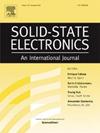Study on electrical performance of AlGaN/GaN high electron mobility transistor based on cap layer design
IF 1.4
4区 物理与天体物理
Q3 ENGINEERING, ELECTRICAL & ELECTRONIC
引用次数: 0
Abstract
This study investigates the impact of different cap layers on the electrical properties of AlGaN/GaN high electron mobility transistors (HEMTs). By comparing the fabricated AlGaN/GaN HEMTs with GaN and AlN cap layers, it was found that AlN cap layer increases the two-dimensional electron gas (2DEG) density due to its superior passivation and polarization effects, yielding a higher saturation current and boosting breakdown voltage from 615 V (GaN) to 895 V (AlN). Sentaurus TCAD simulations confirm these findings, showing a deeper energy band triangular potential well in AlN-capped HEMTs, leading to a 2DEG electron density of 1.19 × 1013 cm−2, compared to 0.93 × 1013 cm−2 for GaN-capped HEMTs. The larger energy band gap of AlN cap layer provides a more effective potential barrier, reducing electric field intensity and increasing breakdown voltage. Additionally, the novel AlN-AlGaN-GaN and GaN-AlGaN-AlN graded cap layers are proposed to further enhance breakdown voltage, reaching up to 1308 V. These graded structures balance the electric field, block electron leakage, and improve electron transfer, providing a significant performance boost. This study underscores the potential of AlN and graded cap layers for future high-performance HEMTs.
基于帽层设计的AlGaN/GaN高电子迁移率晶体管电性能研究
本研究探讨了不同帽层对AlGaN/GaN高电子迁移率晶体管(HEMTs)电学性能的影响。通过将制备的AlGaN/GaN hemt与GaN和AlN帽层进行比较,发现AlN帽层由于具有良好的钝化和极化效应,提高了二维电子气体(2DEG)密度,产生了更高的饱和电流,并将击穿电压从615 V (GaN)提高到895 V (AlN)。Sentaurus TCAD模拟证实了这些发现,在aln封顶的hemt中显示出更深的能带三角形势阱,导致2DEG电子密度为1.19 × 1013 cm−2,而gan封顶的hemt为0.93 × 1013 cm−2。AlN帽层更大的能带隙提供了更有效的势垒,降低了电场强度,提高了击穿电压。此外,还提出了新型AlN-AlGaN-GaN和GaN-AlGaN-AlN梯度帽层,进一步提高击穿电压,最高可达1308 V。这些梯度结构平衡了电场,阻止了电子泄漏,改善了电子转移,提供了显著的性能提升。这项研究强调了AlN和分级帽层在未来高性能hemt中的潜力。
本文章由计算机程序翻译,如有差异,请以英文原文为准。
求助全文
约1分钟内获得全文
求助全文
来源期刊

Solid-state Electronics
物理-工程:电子与电气
CiteScore
3.00
自引率
5.90%
发文量
212
审稿时长
3 months
期刊介绍:
It is the aim of this journal to bring together in one publication outstanding papers reporting new and original work in the following areas: (1) applications of solid-state physics and technology to electronics and optoelectronics, including theory and device design; (2) optical, electrical, morphological characterization techniques and parameter extraction of devices; (3) fabrication of semiconductor devices, and also device-related materials growth, measurement and evaluation; (4) the physics and modeling of submicron and nanoscale microelectronic and optoelectronic devices, including processing, measurement, and performance evaluation; (5) applications of numerical methods to the modeling and simulation of solid-state devices and processes; and (6) nanoscale electronic and optoelectronic devices, photovoltaics, sensors, and MEMS based on semiconductor and alternative electronic materials; (7) synthesis and electrooptical properties of materials for novel devices.
 求助内容:
求助内容: 应助结果提醒方式:
应助结果提醒方式:


